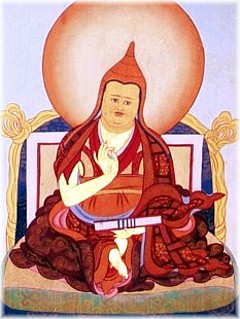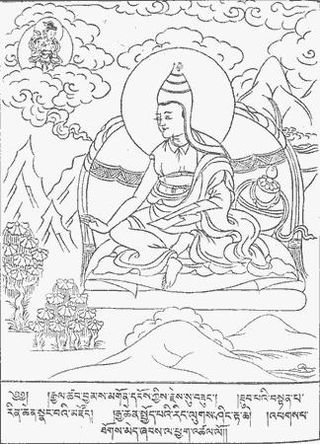
Mādhyamaka, otherwise known as Śūnyavāda and Niḥsvabhāvavāda, refers to a tradition of Buddhist philosophy and practice founded by the Indian Buddhist monk and philosopher Nāgārjuna. The foundational text of the Mādhyamaka tradition is Nāgārjuna's Mūlamadhyamakakārikā. More broadly, Mādhyamaka also refers to the ultimate nature of phenomena as well as the non-conceptual realization of ultimate reality that is experienced in meditation.
The Abhidharmakośabhāṣya, Abhidharmakośa for short, is a key text on the Abhidharma written in Sanskrit by the Indian Buddhist scholar Vasubandhu in the 4th or 5th century CE. The Kośa summarizes the Sarvāstivādin Abhidharma in eight chapters with a total of around 600 verses and then comments on it. This text was widely respected and used by schools of Buddhism in India, Tibet and East Asia. Over time, the Abhidharmakośa became the main source of Abhidharma and Sravakayana Buddhism for later Mahāyāna Buddhists.

Tsongkhapa was an influential Tibetan Buddhist monk, philosopher and tantric yogi, whose activities led to the formation of the Gelug school of Tibetan Buddhism. He is also known by his ordained name Losang Drakpa or simply as "Je Rinpoche". He is also known by Chinese as Zongkapa Lobsang Zhaba or just Zōngkābā (宗喀巴).

Dharmakīrti, was an influential Indian Buddhist philosopher who worked at Nālandā. He was one of the key scholars of epistemology (pramāṇa) in Buddhist philosophy, and is associated with the Yogācāra and Sautrāntika schools. He was also one of the primary theorists of Buddhist atomism. His works influenced the scholars of Mīmāṃsā, Nyaya and Shaivism schools of Hindu philosophy as well as scholars of Jainism.

Jamgön Ju Mipham Gyatso, or Mipham Jamyang Namgyal Gyamtso (1846–1912) was a very influential philosopher and polymath of the Nyingma school of Tibetan Buddhism. He wrote over 32 volumes on topics such as painting, poetics, sculpture, alchemy, medicine, logic, philosophy and tantra. Mipham's works are still central to the scholastic curriculum in Nyingma monasteries today. Mipham is also considered one of the leading figures in the Rimé (non-sectarian) movement in Tibet.
The Svātantrika–Prāsaṅgika distinction is a doctrinal distinction made within Tibetan Buddhism between two stances regarding the use of logic and the meaning of conventional truth within the presentation of Madhyamaka.
The Guhyagarbha Tantra is the most important Buddhist tantra of the Mahayoga class and the primary tantric text studied in the Nyingma tradition. It is the main Nyingma source for understanding empowerment, samaya, mantras, mandalas and other Vajrayana topics, and has influenced the Dzogchen tradition. The Nyingma scholar Longchenpa sees it as "the highest summit of all vehicles, the source of all verbal transmissions, the great great shortcut of the vehicle of all Buddhas of the three times, the most secret."
Mahāyoga is the designation of the first of the three Inner Tantras according to the ninefold division of practice used by the Nyingma school of Tibetan Buddhism.
Anuyoga is the designation of the second of the three Inner Tantras according to the ninefold division of practice used by the Nyingma school of Tibetan Buddhism. This schema categorizes various stages of practice, and Anuyoga specifically emphasizes the completion stage of Tantra. As with the other yanas, Anuyoga represents both a scriptural division as well as a specific emphasis of both view and practice. Anuyoga delves into inner practices involving the subtle body, chakras, prana, nadis, and consciousness (bindu). It is particularly suited for individuals whose primary obstacle is passion and is associated with the feminine principle.
The Seven Treasuries, are a collection of seven works, some with auto-commentaries, by the Tibetan Buddhist teacher Longchenpa (1308–1364). They constitute his most influential scholarly output and together provide a systematic overview of exoteric and esoteric topics from the point of view of the Nyingma school's Dzogchen tradition.

Sakya PanditaKunga Gyeltsen was a Tibetan spiritual leader and Buddhist scholar and the fourth of the Five Sakya Forefathers. Künga Gyeltsen is generally known simply as Sakya Pandita, a title given to him in recognition of his scholarly achievements and knowledge of Sanskrit. He is held in the tradition to have been an emanation of Manjusri, the embodiment of the wisdom of all the Buddhas.
Rongzom Chökyi Zangpo, widely known as Rongzom Mahapandita, Rongzom Dharmabhadra, or simply as Rongzompa, was one of the most important scholars of the Nyingma school of Tibetan Buddhism. Together with Longchenpa and Ju Mipham, he is often considered to be one of the three "omniscient" writers of the school. His elder contemporary Atiśa (980–1054) considered Rongzompa to be an incarnation of the Indian ācārya Kṛṣṇapāda, the Great. The Tibetan historian Gö Lotsawa (1392–1481) said of Rongzom that no scholar in Tibet was his equal.

The Abhisamayālaṅkāra "Ornament of/for Realization[s]", abbreviated AA, is one of five Sanskrit-language Mahayana śastras which, according to Tibetan tradition, Maitreya revealed to Asaṅga in northwest India circa the 4th century AD. Those who doubt the claim of supernatural revelation disagree whether the text was composed by Asaṅga himself, or by someone else, perhaps a human teacher of his.

Trülku Drakpa Gyeltsen (1619–1656) was an important Gelugpa lama and a contemporary of the 5th Dalai Lama (1617–1682). His Seat was the upper residence of Drepung Monastery, a famous Gelug gompa located near Lhasa.
The Madhyamakālaṃkāra is an 8th-century Buddhist text, believed to have been originally composed in Sanskrit by Śāntarakṣita (725–788), which is extant in Tibetan. The Tibetan text was translated from the Sanskrit by Surendrabodhi and Jñānasūtra.
The Madhyamakāvatāra is a text by Candrakīrti on the Mādhyamaka school of Buddhist philosophy. Candrakīrti also wrote an auto-commentary to the work, called the Madhyamakāvatārabhasya.
Samten Migdrön is a Tibetan text of historical importance for the historical relationship of Dzogchen and Zen as well identifying the view of its author, Nubchen Sangye Yeshe.

Pawo Tsuglag Threngwa (1504–1566), the second Nenang Pawo, was a Tibetan historian of the Karma Kagyu. He was a disciple of Mikyö Dorje, 8th Karmapa Lama. He was the author of the famous mkhas pa'i dga' ston, A Scholar's Feast, addressing history of Buddhism in India and its spread in Tibet, as well as the history of Tibet.
Of Tsuklak Trengwa's many students, his chief disciples included the Ninth Karmapa Wangchuk Dorje, the Fifth Zhamar Konchok Yenlag, and the Third Tsurpu Gyeltsab, Drakpa Peljor.
Serdok Penchen Sakya Chokden was one of the most important religious thinkers of the Sakya school of Tibetan Buddhism. He was a student of Rongtön Shecha Kunrig (1367-1449), Dönyö Pelwa, Künga Zangpo and many other Tibetan scholars. He also received empowerments and studied under several Kagyu lineages. Sakya Chokden's seat was the Thubten Serdogchen monastery in south Shigatse.
The Svatantrika-Prasaṅgika distinction is a set of arguments about two different positions of emptiness philosophy which are debated within the Mahayana school of Buddhism. It is most prominently discussed in Tibetan Buddhism where Prāsaṅgika and Svātantrika, are viewed to be different forms of Madhyamaka philosophy.








